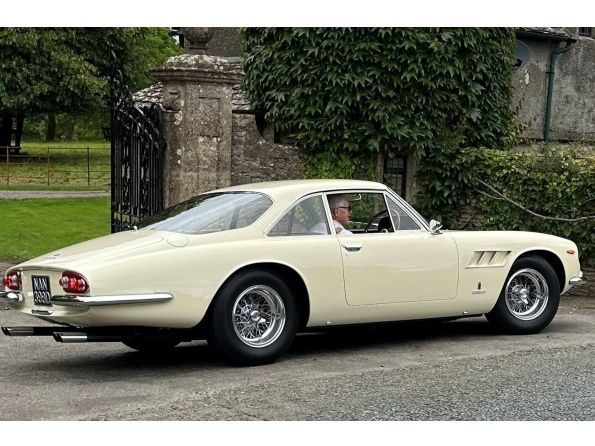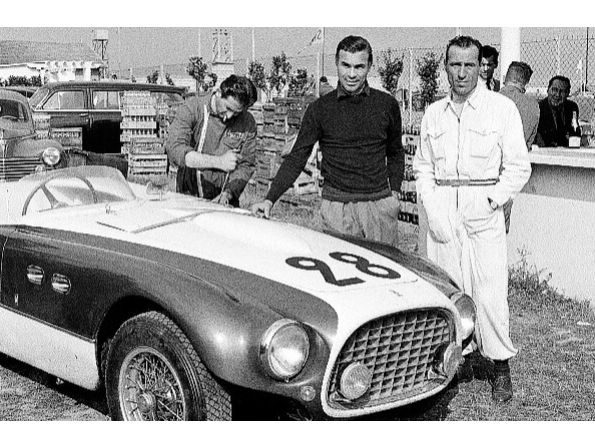Categories more
- Adventures (17)
- Arts / Collectables (15)
- Automotive (37)
- Aviation (11)
- Bath, Body, & Health (77)
- Children (6)
- Cigars / Spirits (32)
- Cuisine (16)
- Design/Architecture (22)
- Electronics (13)
- Entertainment (4)
- Event Planning (5)
- Fashion (46)
- Finance (9)
- Gifts / Misc (6)
- Home Decor (45)
- Jewelry (41)
- Pets (3)
- Philanthropy (1)
- Real Estate (16)
- Services (23)
- Sports / Golf (14)
- Vacation / Travel (60)
- Watches / Pens (15)
- Wines / Vines (24)
- Yachting / Boating (17)
Published
08/16/2024 by Salon PrivéIn the 1950s and ‘60s, that journey could be perfectly book-ended by two of Salon Privé’s star models in its Ferraris of the ‘50s and ‘60s class, presented at Blenheim Palace later this month: a 1953 166 MM and a 1966 500 Superfast.
As with all other entrants in this class, the 166 and 500 have attained a Classiche Certificate of Authenticity from the Ferrari factory in Modena. Authenticity is only awarded to running cars that satisfy exacting originality criteria for chassis, engine, gearbox, suspension, brakes, wheels, bodywork and interior. It ensures Salon Privé’s Ferraris of the ‘50s and ‘60s class features only the very finest classic Ferraris.
1953 Ferrari 166 MM/53 Spider by Vignale – chassis #0308M
When first presented at the Turin Motor Show in 1949, the 166 MM (‘MM’ in tribute to a 166 C Berlinetta that had won the Mille Miglia the previous year) was to be Ferrari’s challenger in the long-distance racing arena. Initially produced with bodies by Milanese carrozzeria Touring, using its famed ‘Superlight’ construction method, the 166 MM was powered by a 60° V12 engine displacing a mere 1995 cc, or 166.25cc per cylinder, gifting the car its moniker. The engine was an advanced unit, by any measure, with a single overhead cam in each cylinder bank and a trio of Weber 32 DCF carburettors feeding its thirst and contributing to an output of 140hp. That equated to a remarkable top speed of 220km/h (136mph).
Ferrari quickly capitalised on the 166 MM’s speed and lightness, the model winning the three most essential motorsport events of the time: the Mille Miglia, Targa Florio and 24 Hours of Le Mans. But by 1953, despite being in its final year of production, the 166 MM evolved visually and technically.
Changes to its V12 engine, including upgraded roller-cam followers and revised Weber 36 IF4C carburettors with four chokes, raised power by up to 20hp, to 160hp. Other coachbuilders started to produce bodies for the upgraded model (now known as ‘166 MM/53’), too: Pinin Farina produced a rakish Berlinetta version, as did Vignale, along with a Spider. And it’s one of the Vignale cars appearing at Blenheim this month.
Originally ordered as a Berlinetta, its first owner, Porfirio Rubirosa, had it rebodied as a Spider – the fifth of six such cars built - before taking delivery. A Dominican diplomat, Rubirosa was a larger-than-life character who enjoyed a jet-setting lifestyle; as well as being a successful professional polo player, he was romantically involved with many of the era’s biggest Hollywood stars, including Zsa Zsa Gabor, Rita Hayworth and Marilyn Monroe.
However, Rubirosa’s competition career with chassis 0308M wasn’t quite so high-profile and only included one race: the 1953 12 Hours of Reims. Sharing the drive with Pierre Leygonie, the pairing achieved the ninth-fastest lap of the race before mechanical problems forced a retirement. Soon after the race, Rubirosa was dismissed from his post in Paris, and 0308M was returned to Maranello to be prepared for sale. After Ferrari sold the car, it was campaigned through 1954 and ’55 by French driver Fernand Tavano, before returning to the factory once again. After a spell with Belgian Ferrari concessionaires Garage Francorchamps, the 166 MM passed through three more owners in Belgium and France between 1956 and ’58, during which time it was entered in a series of hill climbs and grands prix. In 1958, London dealership, The Chequered Flag, imported the car and sold it to John Vivian Stanbury, who had recently been appointed chief designer at Rolls-Royce Motor Cars.
But in 1960, 0308M was bought by Bernard Worth, who was to keep the car for the next 63 years. Always registered as ‘72 SMK’, it has participated in a remarkable variety of events during that time, including club races during the mid-1960s; the Ferrari Owners’ Club of Great Britain Inaugural Meeting in 1967; the Le Mans Cinquantenaire Festival in 1973; two editions of the 1000 Miglia Storica during the 1980s; and the Le Mans Legend race in 2001. In recent years, it has been a regular attendee at the Ferrari Owners’ Club of Great Britain annual meeting and other prestigious shows. Since being purchased by its current owner, Lord Bamford, in 2023, the car has undergone a sympathetic restoration undertaken by Clark & Carter to take the vehicle back to how it was initially specified by Rubirosa when it was new.
1966 Ferrari 500 Superfast – chassis #8897SF
There couldn’t be a starker contrast to the pared-back, competition-focused 166 MM than Salon Privé’s opulent (by Ferrari’s standards) 500 Superfast. Built for a rarified clientele, but with a weather eye to the prosperous US market, only 37 500 Superfasts left Ferrari’s factory, and of those, only eight were right-hand-drive UK market cars. Salon Privé’s car – chassis 8897 – is not only one of those but also the very last 500 Superfast to be produced by Ferrari. In the UK, its exclusivity would have been sealed with a new list price in 1966 of £11,518 – almost twice that of its 275 GTB/4 sibling.
The 500 Superfast had its origins in Ferrari’s Lampredi-engined 340-/342-/375-series cars of the early 1950s, which was then further developed into the 410 Superamerica range from 1956-’59, complete with its independent coil-sprung front suspension, and power from a 4962cc version of Lampredi’s long-block V12 engine. The 410 SA then evolved into the 400 Superamerica series, changing to a smaller 4-litre Colombo V12 engine. Battista Farina remained at the design-helm and refined his ‘Aerodinamico’ thinking still further with the pretty 400 SA Coupé, a stunning example of which will be joining the 500 Superfast at Salon Privé’s Concours. While the two are quite different mechanically and in their external detailing, the similarity of the cars’ Pininfarina (as it became known from 1961) designs is apparent.
When it launched at the Geneva Show in 1964, the 500 Superfast was the most extravagant and expensive road car in Ferrari’s range. It also used Maranello’s largest and most powerful V12 engine, which retained the displacement of the earlier 5-litre Lampredi units but blended it with features from Ferrari’s Colombo-designed engines to produce a claimed output of 400bhp. This was enough to gift the 500 Superfast a top speed of 170mph – faster than any other production car at the time.
Salon Privé’s car, as well as being the last of the line, is also one of only 10 fitted with factory air conditioning and originally one of two with power-assisted steering (though after this failed early in its life, the system was never reinstated). First registered with the number ‘KGH 8D’ by Ferrari’s UK distributor, Maranello Concessionaires, in August 1966, the car’s first owner was a Mr. Samuels. After his passing the following year, the 500 had one more owner for a brief period, during which time it was repainted in Bianco Polo before being acquired by Ferrari collector Jack Crowther, who kept the car – then registered ‘NAN 399D’ – until 1985. Three more owners followed until the 500 was taken on by Simon Kidston in 2017 and recommissioned by marque specialists GTO Engineering. It then resided in a British collection for the next few years before being sold to its current owner, New Zealand-based Andrew Bagnall. Since then, Bob Houghton Limited has returned the paint to its original Avorio colour and undertaken a complete re-chrome and interior renovation.
Quote from Andrew Bagley, Salon Privé Concours Chairman
“These two unique Ferraris are the crowning glories of Salon Privé’s Ferraris of the ‘50s and ‘60s class. They perfectly illustrate Enzo’s pragmatism in developing an exclusive and profitable road car business to fund his passion for racing during the 1950s and ‘60s before Fiat bought into the business. While the 166 MM and 500 Superfast are polar opposites – and the same contrasts can be found everywhere in this eclectic class – the same race-bred engineering permeates through all the cars, whether they were designed for track or road. One of my favourite classes this year.”
Other Ferrari highlights include:
1950 Ferrari 166 MM/212 – One of the most famous Ferraris, and one which led its namesake Mille Miglia road race in 1951. This 166’s Touring-bodied chassis is powered by a 2.6-litre engine from a 212 Export model.
1957 Ferrari 335 S – First raced in the 1957 Sebring 12 Hour race by Peter Collins and Maurice Trintignant, coming in 6th, chassis #0674 went on to have an illustrious race career in the hands of drivers like Stirling Moss, Mike Hawthorn and Wolfgang von Tripps.
1963 Ferrari 400 Superamerica – An exceptional matching-numbers car, and a perfect complement to the 500 Superfast. Painted in Oro Chiaro, this SA was originally sold by Ferrari’s North America distributor Luigi Chinetti when new.
1965 Ferrari 275 GTB – fully restored short-nose series-1 model, painted in rare Verde Pino colour.
1985 Ferrari 288 GTO – One of only 18 lightweight cars produced. Completely original, and in single ownership since 1988, this is the first time that the car has appeared at Blenheim Palace.
1990 Ferrari Testa Rossa – One of 438 right-hand-drive cars produced, this unrestored, two-owner TR has covered just 101 miles from new.
1996 Ferrari F50s – two cars from a total production of 349, one painted in rare Rosso Barchetta, the other in Rosso Corsa.
Entries for the 2024 Salon Privé Concours presented by Aviva Private Clients are now closed. For 2025 entries, please get in touch with Concours coordinator Nick Wilkes on +44 (0)7795 213 361 or at NickW@salonpriveconcours.com
















